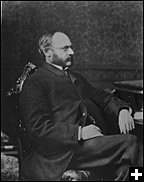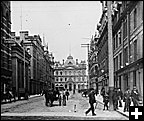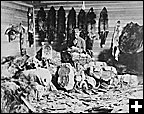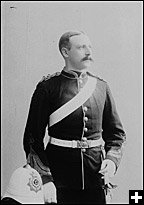Common menu bar links
Canadian statistics in 1892
Archived Content
Information identified as archived is provided for reference, research or recordkeeping purposes. It is not subject to the Government of Canada Web Standards and has not been altered or updated since it was archived. Please contact us to request a format other than those available.

In 1887, George Johnson, a statistician and the Ottawa correspondent for the Toronto Mail, was appointed the Department of Agriculture’s first senior full-time statistician.
He had proven his worth as the author of statistical texts by the time of his appointment. In 1886, he was commissioned by the department to write a compendium-type handbook for the Colonial and Indian Exhibition held in London. Johnson wrote many of his own statistical volumes, including a one-time publication called Johnson’s Graphic Statistics, which was published in 1887.
The cover page of Johnson’s Graphic Statistics displayed the words of poet Alfred, Lord Tennyson: “Things seen are mightier than things heard.” This reflected Johnson’s view that statistics were not accessible to everyday Canadians and that data needed to be represented visually. Johnson filled his statistical volumes with bar and line graphs in different shades and colours.
Changes to the publications, 1889 to 1893
In 1889, the annual statistical book of Canada, which had been known by several different names, was once again renamed—it was called the Statistical Year-Book of Canada. No explanation was given for the change and little adjustment was seen in the publication’s format until later.
With Johnson’s involvement, the publication began to take on an official form and would, in the years to come, become “the subject of regular comments in the minister’s reports, where the main emphasis was on the difficulties of keeping up with the demand, which increasingly had an international character.” Also, the contents of the book increased and the number of pages went up 50% in 1893.
Johnson introduced the 1892 volume with confidence: “Every page of the present issue has been carefully examined for the purpose of detecting errors and removing inadvertent traces of political party bias. The Year Book for 1892 will be found to be the most complete of the series.”
Counting the people

The population, according to the 1891 Census results, was 4,833,239 people.
Urban life was on the rise—it had gone from 21.1% of the population in 1881 to 28.7% in 1891. This growth was phenomenal and needed an explanation. The 1892 edition found it “necessary to point out that, in many cases, additions to the population have been caused by the annexation of adjacent territory since 1881—notably in the cases of Montreal, Toronto, Ottawa, London and St. John.”
In 1891, nearly 93% of this increase in the population was from those born in the country. The other 7% was from foreign-born people who largely came from England and other British possessions (490,232), the United States (80,915) and Germany (27,752).
In 1891, French-speaking Canadians represented 29% of the population. The Aboriginal population of Canada was estimated at 121,638 people, which represented 2.5% of the population.
Communicating and connecting

Although many of the Dominion’s telegraph lines belonged to private companies, government-owned and -operated lines were built where there was public interest for communication. They were built to the shores of the Gulf of the St. Lawrence, the Maritimes and British Columbia, and “also for the advancement of settlement in the North-west Territories.”
On June 30, 1892, the Government of Canada owned close to 2,700 miles of telegraph lines. They cost nearly $49,000 to maintain, which was significantly higher than the $10,000 in revenue gathered from their use.
The Bell Telephone Company of Montréal operated almost the entire system in Ontario, Quebec and Manitoba. It had “492 offices, 26,651 sets of instruments in use, 6,204 miles of poles and 32,214 miles of wire.”
Manufacturing and fisheries

With the increases in the urban population were increases in manufacturing. The number of industrial establishments in Canada increased 52% from 1881 to 1891. Whereas Canada had 49,923 such establishments and 254,935 employees in 1881, it had 75,768 establishments and 367,865 employees in 1891.
On February 15, 1888, a British–American Commission convened in Washington. As a result of this meeting, American vessels were admitted to Canadian fisheries upon buying a license for $1.50 per ton. By 1892, 108 licenses were bought for a total of $13,410, compared with the 36 licenses bought in 1888 for a total of $3,831.
In 1892, the year’s catch of cod was valued the highest at $4.1 million, salmon at $2.2 million, herring at $2.0 million, lobster at $2.0 million and whitefish and mackerel at almost $1.5 million each.
Defending the country

By the Consolidated Militia Act, passed on May 25, 1883, “the militia of Canada is declared to consist of all the male inhabitants of Canada of the age of 18 years or upwards and under 60, not exempted or disqualified by law.” The militia was divided further by ages and marital status, favouring the young and ‘unburdened’ before all else. Those exempt included “Judges, clergymen and ministers of all religious denominations, professors in colleges and teachers in religious orders, persons engaged in the collection or management of revenue, the wardens and officials of all penitentiaries and lunatic asylums, persons physically disabled, and any person being the only son of a widow and her only support.”
The permanent militia contained about 1,000 people and was composed of the Royal Canadian Dragoons, the Royal Canadian Artillery and the Royal Canadian Regiment of Infantry. The active militia contained nearly 34,000 men and was composed of a cavalry, field artillery units, garrison, infantry and engineers. The permanent and active militia also contained nearly 3,000 horses.
